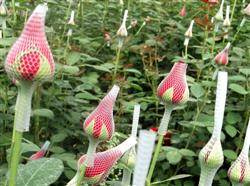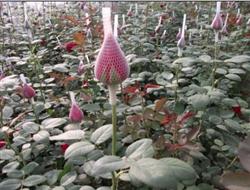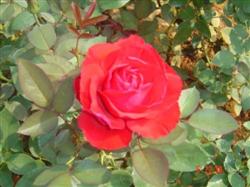Cultivation techniques of Red Rose

Red Rosewood Red Rosewood (Ochrosia coccinea) is a plant of the genus Apocynaceae distributed from Madagascar to Polynea in the Pacific Ocean. The red rosewood is a small evergreen tree with white milk, gray stems and bright green twigs. The leaves are beautiful, nearly leathery or sturdy paper, usually 3-leaf whorls, flowers such as ivory white, fragrant, fruit is a hard drupe, shaped like a peach, rose-red when ripe, set off with green leaves, more gorgeous. The flowering period of this plant is mainly concentrated from April to June, but it can blossom almost all the year round in warm climates, while the fruit period is from the second half of the year to the end of the year. This kind of plant, which is fragrant and fruity, and has a long flower and fruit period, is a kind of tree species with great ornamental value. Rosa rugosa can grow in sandy soil, clay or saline-alkali soil, and the deep, loose and fertile sandy loam is more suitable. However, a variety of other soils can also grow, so they can be widely used in the greening layout of Shishan scenic spots, factories and mining areas. It is a kind of excellent green new tree species with great development potential. Propagation method because this plant is rich in milk, cutting propagation is more difficult; therefore, the method of seed propagation is widely used for seedling production. (1) the fruit ripening period of seed harvest and treatment is generally from mid-November to early December, and the fruit can be harvested after it looks red; after harvest, the fruit can be sealed in a nylon film bag (plastic (11280,-35.00,-0.31%) plastic bucket can also be sealed for about a week. When the pulp softens or decays, remove the pulp, wash it with clean water and leave it in a ventilated and dry place to dry. (2) the seeds sown and harvested can be stored at a temperature of about 5 ℃ to sow in the following spring after being treated and dried, but their vigor will be affected if they are stored at low temperature for too long, so it is suitable to pick and sow in the south where the climate is warmer. Before sowing, the shell of the fruit must be broken and the seeds must be soaked in water of about 20 ℃ for 8 hours before sowing, which is beneficial to early germination. The nursery bed generally chooses sandy loam, the height of the bed is about 20 centimeters, and the top is covered with a layer of clean river sand. Then spread the seeds evenly, then cover the seeds with a layer of river sand about 2 centimeters thick, and keep the seedbed moist after sowing. If the seedbed temperature is about 20 ℃, it can sprout and emerge after 2 weeks. (3) under the condition of suitable seedling management and transplanting temperature, the seedlings can be transplanted into nutrition bag after growing 4 true leaves, and appropriate amount of phosphorus and potassium fertilizer or compound fertilizer can be applied at seedling stage, which can be planted in the garden after 1-2 years of growth. (Ochrosia coccinea) is a rose plant of the family Apocynaceae, distributed from Madagascar to Polynea in the Pacific Ocean. The red rosewood is a small evergreen tree with white milk, gray stems and bright green twigs. The leaves are beautiful, nearly leathery or sturdy paper, usually 3-leaf whorls, flowers such as ivory white, fragrant, fruit is a hard drupe, shaped like a peach, rose-red when ripe, set off with green leaves, more gorgeous. The flowering period of this plant is mainly concentrated from April to June, but it can blossom almost all the year round in warm climates, while the fruit period is from the second half of the year to the end of the year. This kind of plant, which is fragrant and fruity, and has a long flower and fruit period, is a kind of tree species with great ornamental value. Rosa rugosa can grow in sandy soil, clay or saline-alkali soil, and the deep, loose and fertile sandy loam is more suitable. However, a variety of other soils can also grow, so they can be widely used in the greening layout of Shishan scenic spots, factories and mining areas. It is a kind of excellent green new tree species with great development potential. Propagation method because this plant is rich in milk, cutting propagation is more difficult; therefore, the method of seed propagation is widely used for seedling production. (1) the fruit ripening period of seed harvest and treatment is generally from mid-November to early December, and the fruit can be harvested after it looks red; after harvest, the fruit can be sealed in a nylon film bag (plastic (11280,-35.00,-0.31%) plastic bucket can also be sealed for about a week. When the pulp softens or decays, remove the pulp, wash it with clean water and leave it in a ventilated and dry place to dry. (2) the seeds sown and harvested can be stored at a temperature of about 5 ℃ to sow in the following spring after being treated and dried, but their vigor will be affected if they are stored at low temperature for too long, so it is suitable to pick and sow in the south where the climate is warmer. Before sowing, the shell of the fruit must be broken and the seeds must be soaked in water of about 20 ℃ for 8 hours before sowing, which is beneficial to early germination. The nursery bed generally chooses sandy loam, the height of the bed is about 20 centimeters, and the top is covered with a layer of clean river sand. Then spread the seeds evenly, then cover the seeds with a layer of river sand about 2 centimeters thick, and keep the seedbed moist after sowing. If the seedbed temperature is about 20 ℃, it can sprout and emerge after 2 weeks. (3) under the condition of suitable seedling management and transplanting temperature, the seedlings can be transplanted into nutrition bag after growing 4 true leaves, and appropriate amount of phosphorus and potassium fertilizer or compound fertilizer can be applied at seedling stage, which can be planted in the garden after 1-2 years of growth.
- Prev

Common diseases and insect pests of rose and their control
The common diseases of rose are rust, black mildew, powdery mildew and so on. Rust often harms the leaves, young branches and flowers of roses. In the early stage of the disease, the leaves appear red spots such as rust, and when the leaves are serious, the leaves become scorched and fall off, affecting flowering in the coming year. Diseased leaves should be removed in time and destroyed centrally. It can also be sprayed every half month from May to August.
- Next

Key points of Management of Datian Rose after Flood
1. Diseases and insect pests are not easy to occur, especially the most fatal downy mildew in the growth of cut rose flowers. The reason: because the key point of rose high pile cultivation technique is that the vegetative branches are respectively in the soil moisture, the rose pile is about 50 cm away from the soil moisture surface, there are no leaves under the pile, and the ventilation and permeability is very good, which is not beneficial to the growth of diseases and insect pests.
Related
- Fuxing push coffee new agricultural production and marketing class: lack of small-scale processing plants
- Jujube rice field leisure farm deep ploughing Yilan for five years to create a space for organic food and play
- Nongyu Farm-A trial of organic papaya for brave women with advanced technology
- Four points for attention in the prevention and control of diseases and insect pests of edible fungi
- How to add nutrient solution to Edible Fungi
- Is there any good way to control edible fungus mites?
- Open Inoculation Technology of Edible Fungi
- Is there any clever way to use fertilizer for edible fungus in winter?
- What agents are used to kill the pathogens of edible fungi in the mushroom shed?
- Rapid drying of Edible Fungi

